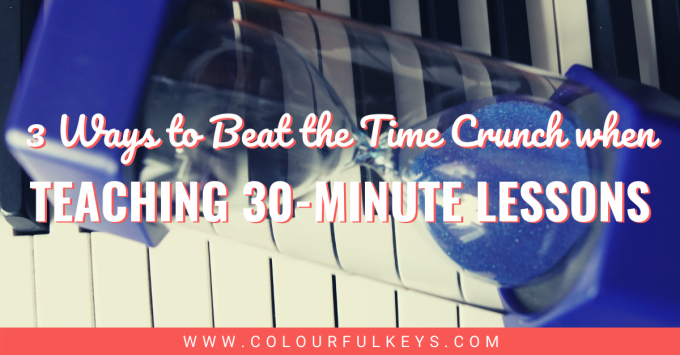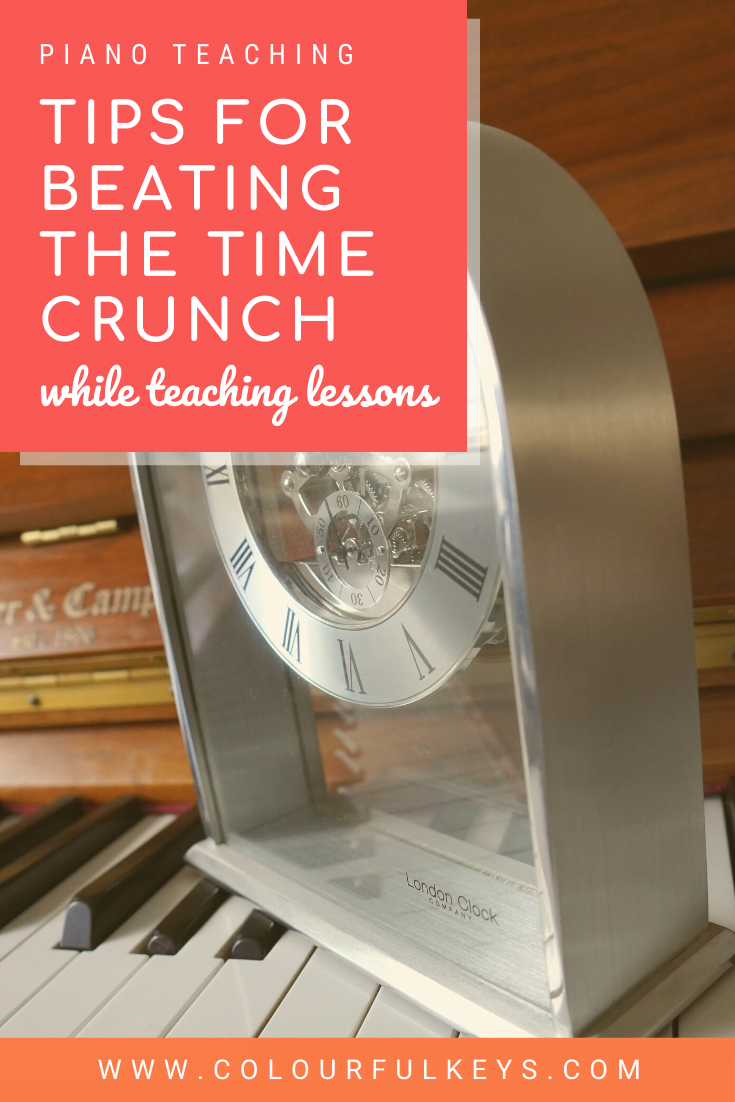This post about teaching 30-minute piano lessons was originally published in July 2016 and updated in July 2020.
Are you stuck in the piano lesson time crunch conundrum? Do you struggle to fit in everything you want in just 30 minutes?

I don’t know exactly when half-hour weekly piano lessons become the norm…but I think at some stage all of us teachers have cursed the person who started it! If we want to create well-rounded pianists with a comprehensive music understanding, 30 minutes can sometimes feel like 5.
We want to cover music theory concepts, review old pieces, start new repertoire, scales, chords, composing, improvising, sight-reading…etc, etc, etc.
There is no magic way to make 30 minutes last longer than half an hour. But if there are a few little tricks I’ve learned to avoid teacher stress when it comes to this time crunch conundrum.
Don’t Offer 30-Minute Lessons
Before you say anything, no, this is not one of the three solutions I’m suggesting. I would never mislead you like that. 😉
It is a solution though. If you really hate teaching 30-minute piano lessons, consider getting rid of them altogether. Who says you have to teach in half-hour slots anyway? Tradition? That’s not a good enough reason to stress yourself out.
So, think about the possibility of changing your standard format. At least consider it.
Now, there are plenty of reasons why you might not be able to do away with the 30-minute lessons. You might have a packed timetable and not want to turn away any current students. Or maybe your demographic just couldn’t do that financially.
Assuming you do have to cram everything into 30 minutes, let’s talk about some solutions.
1. Rotating
Most teachers see some things as “core elements” and others as “extra stuff”. It’s reasonably easy to divide these things up if you think about your main goals for your students.
If your main goal is to have great readers, then method books and sight-reading could be “core”. Anything else you want to teach like improvisation, rote pieces and composing might be “extra”.
What goes in these two categories depends on your own goals, but for this method to work you do need to know which is which.

Once you’ve separated the core elements from the extra stuff, estimate how much time you want to spend per lesson on each of the core elements. Whatever amount of time you’re left with is your rotating time. Everything else goes in this slot, one per week, and they simply rotate from one week to the next.
You may not get a lot of time on each of your extra elements, but that’s kind of the point. You can rest easy knowing the core stuff is covered, and still have the variety provided by the extra stuff.
Need more help planning out your piano lessons? I’ve got just the thing for you on my Planning Piano Lessons page.
2. Theme Months
Another way to fit in the extras is to run studio-wide themes each month.
For instance, you could have a composing month when the last few minutes of everyone’s lesson are spent working on an original piece.
Another month might be note flashcard training month, when you would start every lesson with a timed flashcard challenge.

These types of monthly themes can be great fun, while also building a sense of community in your studio. You can display the progress and projects each month to inspire your other students, and maybe even get a little friendly competition going.
3. Group Lessons
Adding group lessons into your studio calendar is a fantastic way to free up some lesson time.
Although lots of concepts are taught very effectively in one-on-one weekly lessons, some things are actually taught more easily in a group setting. Even if you can only fit a couple of group lessons into a year, you can still get a lot done during this time.

I love to teach music theory concepts through games at group lessons. I do use games in my individual lessons, too, but let’s face it: It’s a lot more fun to play games with your peers than your teacher!
Do 30-minute lessons stress you out?
Do you teach 30-minute piano lessons? What solutions have you found to squeeze everything in? Let’s hear your best time-saving strategies in the comments below or in the Vibrant Music Studio Teachers group on Facebook.

Hi there.
Thanks for your sharing and your advised. I’m a piano teacher, too. I’m from Vietnam. Keep moving! I think you had a good energy and a lot of passion for teaching children.
Sometimes I reschedule a missed lesson by extending other lessons in the month by 15 minutes or so. I know that doesn’t work in everyone’s schedule, but having two of the monthly lessons be 45 minutes and one be 30 minutes (and one week skipped) actually helps me feel “caught up” with those extra things that are so important.
Glad to hear that works for you Hannah. I wouldn’t encourage it for every teacher as folks might start to expect that extra time – but hey, every studio is different. 😉
This!!! I made allowances for adding time to lessons and making up lessons but I’ve had too many parents try and take advantage of my time and I had to become very strict about missed lessons, etc.
I work as a peripatetic piano teacher in primary schools and the majority of my lessons are only 20 minutes long! I tend to have a different lesson focus each week like theory focus one week, composition the next, repertoire the next etc, otherwise it’d be impossible for me to cover all elements!